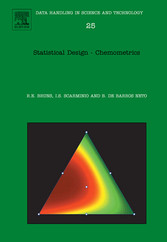Search and Find
Service
Cover
1
Contents
8
Preface
6
How statistics can help
12
Statistics can help
13
Empirical models
15
Experimental design and optimization
16
When the situation is normal
20
Applications
81
From home to work
81
Bioequivalence of brand-name and generic medicines
87
Still more beans?
88
Marine algae productivity
92
Applying the normal distribution
65
Making comparisons with a reference value
65
Determining sample size
69
Statistically controlling processes
71
Comparing two treatments
75
Random sampling in normal populations
56
Linear combinations of random variables
52
Covariance and correlation
48
The normal distribution
34
Calculating probabilities of occurrence
35
Using the tails of the standard normal distribution
40
Why is the normal distribution so important
43
Calculating confidence intervals for the mean
45
Interpreting confidence intervals
46
Populations, samples and distributions
25
How to describe the characteristics of the sample
28
Errors
21
Types of error
22
Changing everything at the same time
94
A 2² factorial design
96
Calculating the effects
97
Geometrical interpretation of the effects
100
Estimating the error of an effect
100
Interpreting the results
104
An algorithm for calculating the effects
106
The statistical model
109
A 2³ factorial design
114
Calculating the effects
115
Estimating the error of an effect
117
Interpreting the results
118
The statistical model
121
A 24 factorial design
121
Calculating the effects
122
Estimating the error of an effect
123
Normal probability plots
125
Evolutionary operation with two-level designs
130
Blocking factorial designs
134
Applications
136
Resin hydrolysis
136
Cyclic voltammetry of methylene blue
137
Retention time in liquid chromatography
138
Gas separation by adsorption
140
Improving wave functions
142
Performance of Ti/TiO2 electrodes
144
Controlling detergent froth
149
Development of a detergent
151
A blocked design for producing earplugs
153
When there are many variables
158
Half-fractions of factorial designs
159
How to construct a half-fraction
163
Generators of fractional factorial designs
165
The concept of resolution
167
Resolution IV fractional factorial designs
167
Resolution V fractional factorial designs
168
Inert variables and factorials embedded in fractions
169
Half-fractions of maximum resolution
172
Screening variables
174
Resolution III fractional factorial designs
174
Saturated designs
176
How to construct resolution III fractional factorial designs
182
How to construct a 2IV^8-4 fraction from a 2III^7-4 fraction
182
Saturated Plackett–Burman designs
184
Taguchi techniques for quality engineering
186
Applications
190
Adsorption on organofunctionalized silicas
190
Calcium oxalate thermogravimetry
190
Chromatographic analysis of gases
193
Mn-porphyrin catalytic response
195
Oxide drainage in the steel industry
196
Violacein production by bacteria
198
Polyester resin cure
200
Screening design for earplug production
204
Plackett–Burman designs for screening factors
205
Empirical model-building
210
A model for y=f(X)
210
The analysis of variance
220
Confidence intervals
224
Statistical significance of the regression model
229
A new model for y=f(X)
230
Lack of fit and pure error
234
Correlation and regression
242
Applications
244
The spring of air
244
Chromatographic calibration
246
Multivariate calibration
250
Forbidden energy gaps in semiconductors
251
Heat of vaporization determination
252
Another calibration
254
Exploring the response surface
256
Response surface methodology
256
Initial modeling
257
Determining the path of steepest ascent
261
Finding the optimum point
265
The importance of the initial design
270
An experiment with three factors and two responses
271
Treating problems with many variables
279
Central composite designs
284
Box–Behnken designs
288
Doehlert designs
292
Optimal designs
298
Applications
301
6A.1 Mo(VI) catalytic response
301
Osmotic dehydration of pineapple
302
Reducing cholesterol levels
305
Laccase production
307
Increasing the oxygen in air
309
Earplug optimization study — concluding phase
316
Photodegradability of herbicides
319
Mixture modeling
324
Two-component mixtures
325
Three-component mixtures
332
An example of a three-component mixture
335
Cubic models for three-component mixtures
338
Model evaluation
341
Pseudocomponents
343
Other mixture designs
345
Mixtures with more than three components
349
Applications
351
Solvent influence on Fe(III) ion complexation
351
Tensile strength of polymeric materials
355
Cr(VI) catalytic determination
358
Polymer blend conductivity
360
The proof of the pudding is not in the eating
363
Designing new ceramic materials
366
Improving selectivity in high-performance liquid chromatography
369
Simplex optimization
376
The basic simplex
377
The modified simplex
382
The supermodified simplex
391
References
396
Uncited References
396
References
396
Answers to exercises
404
Chapter 2
404
Chapter 3
406
Chapter 4
409
Chapter 5
411
Chapter 6
414
Chapter 7
415
Chapter 8
416
index
418
All prices incl. VAT











